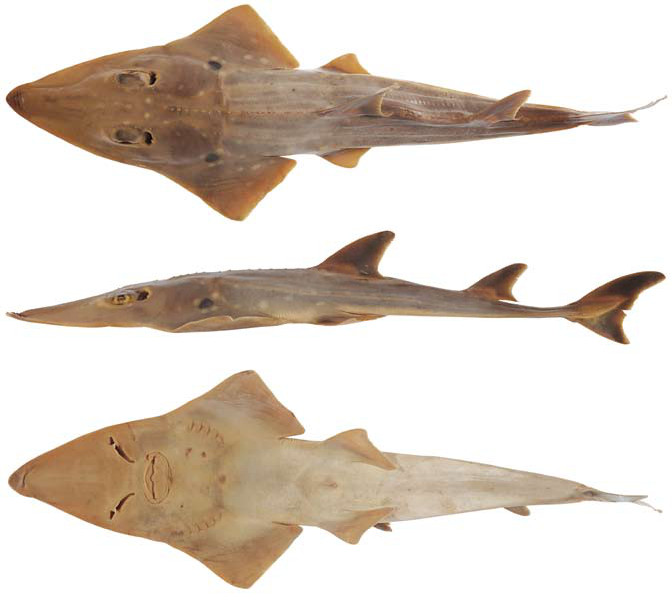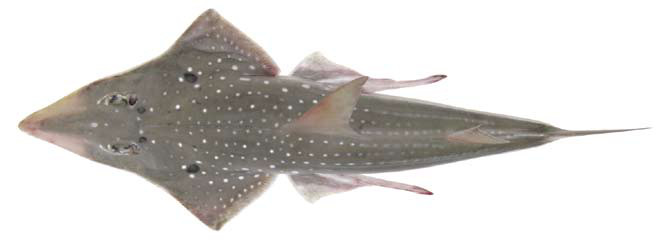Rhynchobatus springeri
Compagno & Last, 2010
Broadnose wedgefish
Classification: Elasmobranchii Rhinopristiformes Rhinidae
Reference of the original description
A new species of wedgefish, Rhynchobatus springeri (Rhynchobatoidei, Rhynchobatidae), from the Western Pacific. CSIRO Marine and Atmospheric Research Paper, 32, 77–88
A new species of wedgefish, Rhynchobatus springeri (Rhynchobatoidei, Rhynchobatidae), from the Western Pacific. CSIRO Marine and Atmospheric Research Paper, 32, 77–88
Image of the original description

Rhynchobatus springeri sp. nov.: A. dorsal view of female holotype (RMNH PISC 35839, 410 mm TL, preserved); B. lateral view of holotype; C. ventral view of holotype; In: Compagno, L.J.V. & Last, P.R. (2010): A new species of wedgefish, Rhynchobatus springeri (Rhynchobatoidei, Rhynchobatidae), from the Western Pacific. CSIRO Marine and Atmospheric Research Paper, 32: 77-88

Rhynchobatus springeri sp. nov.: A. dorsal view of female holotype (RMNH PISC 35839, 410 mm TL, preserved); B. lateral view of holotype; C. ventral view of holotype; In: Compagno, L.J.V. & Last, P.R. (2010): A new species of wedgefish, Rhynchobatus springeri (Rhynchobatoidei, Rhynchobatidae), from the Western Pacific. CSIRO Marine and Atmospheric Research Paper, 32: 77-88
Types
Rhynchobatus springeri
Holotype: RMNH: PISC 35839 ; Paratype: CAS: 229760; CAS: 229759; CAS: 229758; CAS: 229757; CAS: 229755; CAS: 229754; CAS: 229751; CAS: 229750; CAS: 229752; CAS: 229749; CAS: 229748; CAS: 229747; CSIRO: H 7113-01 ; CSIRO: H 7113-01; HUMZ: 96570; HUMZ: 96569; HUMZ: 117525; IPPS: 2009-338; RMNH: PISC 35840; SU: 13330; ZMH: 101280; ZMH: 10259;
Rhynchobatus springeri
Holotype: RMNH: PISC 35839 ; Paratype: CAS: 229760; CAS: 229759; CAS: 229758; CAS: 229757; CAS: 229755; CAS: 229754; CAS: 229751; CAS: 229750; CAS: 229752; CAS: 229749; CAS: 229748; CAS: 229747; CSIRO: H 7113-01 ; CSIRO: H 7113-01; HUMZ: 96570; HUMZ: 96569; HUMZ: 117525; IPPS: 2009-338; RMNH: PISC 35840; SU: 13330; ZMH: 101280; ZMH: 10259;
Description :
Citation: Rhynchobatus springeri Compagno & Last, 2010: In: Database of modern sharks, rays and chimaeras, www.shark-references.com, World Wide Web electronic publication, Version 12/2025
Please send your images of "Rhynchobatus springeri" to info@shark-references.com

Rhynchobatus springeri sp. nov.: reconstructed dorsal view of adult male paratype (IPPS 2009–338, 1126 mm TL, fresh), specimen missing dorsal fins and part of right pelvic fin.; In: Compagno, L.J.V. & Last, P.R. (2010): A new species of wedgefish, Rhynchobatus springeri (Rhynchobatoidei, Rhynchobatidae), from the Western Pacific. CSIRO Marine and Atmospheric Research Paper, 32: 77-88

Rhynchobatus springeri sp. nov.: reconstructed dorsal view of adult male paratype (IPPS 2009–338, 1126 mm TL, fresh), specimen missing dorsal fins and part of right pelvic fin.; In: Compagno, L.J.V. & Last, P.R. (2010): A new species of wedgefish, Rhynchobatus springeri (Rhynchobatoidei, Rhynchobatidae), from the Western Pacific. CSIRO Marine and Atmospheric Research Paper, 32: 77-88
Common names
 Broadnose wedgefish
Broadnose wedgefish
 Broadnose wedgefish
Broadnose wedgefish
Short Description
Original diagnosis after COMPAGNO & LAST, 2010 [9063]: This moderate-sized species is distinguished by the following set of characters: snout broadly wedge-shaped; preoral snout 16-22% of total length; eye small, length 3.1-4.0 in preorbital snout; interorbital space 2.2-2.7 in preorbital snout; mouth hardly bowed, with strong indentation on upper jaw near symphysis and strong protuberance on lower jaw; tooth rows in upper jaw about 52 (holotype); dorsal snout no spines; dorsal tip of snout with no rostral spines or spines; supraorbital spines small but well differentiated, extending from preorbit to end of spiracle; spines of mid-dorsal row relatively well developed; two obvious rows of small scapular spines on each side; origin of first dorsal fin over origin of pelvic fin bases; predorsal space 42-48% of total length; colour pale greyish green above with 3-4 rows of large, white spots extending along the tail; black pectoral marking distinct, usually closely surrounded with 4 white spots (occasionally 3); anterior pectoral disc with narrow whitish margin; orbital membrane with a pair of dark, widely spaced, recurved lines; interorbital space with no alternating light and dark markings; propterygial radials 1-8 + 20-23, mesopterygial radials 4-6, neopterygial radials 4-7, metapterygial radials 23-29, total radials 57-68 (inc. free radials); vertebrae with 12-14 synarcual centra, 18-28 monospondylous precaudal centra, 78-88 precaudal free centra, 33-40 diplospondylous caudal (free) centra, 113-126 total free centra, 127-139 total centra (including synarcual centra).
Original diagnosis after COMPAGNO & LAST, 2010 [9063]: This moderate-sized species is distinguished by the following set of characters: snout broadly wedge-shaped; preoral snout 16-22% of total length; eye small, length 3.1-4.0 in preorbital snout; interorbital space 2.2-2.7 in preorbital snout; mouth hardly bowed, with strong indentation on upper jaw near symphysis and strong protuberance on lower jaw; tooth rows in upper jaw about 52 (holotype); dorsal snout no spines; dorsal tip of snout with no rostral spines or spines; supraorbital spines small but well differentiated, extending from preorbit to end of spiracle; spines of mid-dorsal row relatively well developed; two obvious rows of small scapular spines on each side; origin of first dorsal fin over origin of pelvic fin bases; predorsal space 42-48% of total length; colour pale greyish green above with 3-4 rows of large, white spots extending along the tail; black pectoral marking distinct, usually closely surrounded with 4 white spots (occasionally 3); anterior pectoral disc with narrow whitish margin; orbital membrane with a pair of dark, widely spaced, recurved lines; interorbital space with no alternating light and dark markings; propterygial radials 1-8 + 20-23, mesopterygial radials 4-6, neopterygial radials 4-7, metapterygial radials 23-29, total radials 57-68 (inc. free radials); vertebrae with 12-14 synarcual centra, 18-28 monospondylous precaudal centra, 78-88 precaudal free centra, 33-40 diplospondylous caudal (free) centra, 113-126 total free centra, 127-139 total centra (including synarcual centra).
Distribution
Indo-Malay: from Java (Indonesia) to Thailand, including Borneo, Singapore and the Philippines. [9063] Source: www.gbif.org
Indo-Malay: from Java (Indonesia) to Thailand, including Borneo, Singapore and the Philippines. [9063] Source: www.gbif.org
Biology
Apparently confined mainly to brackish coastal and estuarine habitats in shallow water [9063] Tropical
Apparently confined mainly to brackish coastal and estuarine habitats in shallow water [9063] Tropical
Remarks
shark-references Species-ID=9010; CITES: (see: Protected Species for more details) Convention on International Trade in Endangered Speciesof Wild Fauna and Flora annex: II; Council Regulation 2017/160 annex: B
shark-references Species-ID=9010; CITES: (see: Protected Species for more details) Convention on International Trade in Endangered Speciesof Wild Fauna and Flora annex: II; Council Regulation 2017/160 annex: B
















